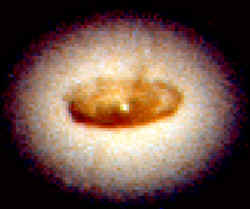Mysterious Cosmic Rays

Earth’s outer atmosphere is regularly blasted by subatomic particles packing so much energy that they defy explanation. These ultrahigh energy cosmic rays (UHECRs) have baffled physicists for decades because no one has found sources powerful enough to generate them in our cosmic neighborhood, yet they could not have traveled far without losing energy. One proposed explanation for UHECRs from 16 years ago has gotten increased attention recently because it requires that neutrinos have mass–a previously heretical idea that now seems probable. In the 21 December PRL a team reports on the first detailed computer simulation of this theory and makes specific predictions that can be tested with observations in the next few years.
Researchers have detected a handful of cosmic rays with energies greater than 1020 eV, but they have yet to locate a nearby source capable of creating them. On the other hand, before traveling much more than 20 million light-years, such energetic protons and neutrons should interact with the ubiquitous cosmic background radiation and leave only lower-energy particles behind. But according to a theory by Thomas Weiler, of Vanderbilt University in Nashville, powerful far-away sources could send out streams of superenergetic neutrinos, which barely interact with the cosmic background, and they might later collide with nearby neutrinos to generate the cosmic rays we see. The theory requires that neutrinos have a mass of between 0.1 and 1 eV, which now seems possible, since the dramatic results from a Japanese neutrino detector earlier this year convinced most experts of the reality of massive neutrinos.
Günter Sigl of the University of Chicago and his colleagues used a computer simulation to model the theory in detail, including complicated chains of particle interactions that occur after the high energy neutrinos strike nearby “relic” neutrinos left over from the Big Bang. They also included the effects of the weak magnetic fields outside our galaxy and the cosmic background radiation at all frequencies. Sigl and his colleagues made at least two critical assumptions, aside from the existence of the high energy neutrinos: that the neutrino mass is about 1 eV and that the gravity of our local supercluster of galaxies causes relic neutrinos to cluster somewhat in our neighborhood. The team’s simulation also had to be consistent with satellite and ground-based observations of high energy gamma rays, cosmic rays, and neutrinos.
Sigl says the results show that the theory is “not completely crazy,” although “you need admittedly rather extreme parameter combinations” to fit all of the observations. But he points out that other proposed explanations for UHECRs are even more exotic, relying on high energy physics notions that are far from proven. This model, in contrast, can include so many particle interactions precisely because they are so well known, although the proposed neutrino sources, such as active galactic nuclei, are still not well understood.
The simulation predicts specific observations for the next five to ten years, as new ground- and satellite-based detectors become available, so these new detectors should be capable of ruling definitively on the model. Weiler says the new simulation is extremely important because it includes all known effects and confirms that the theory is not inconsistent with observations. He agrees that the model’s virtue in comparison to others is its reliance on only well-accepted physics, an idea he says the University of Chicago’s Michael Turner encapsulates in the statement that a good theory “minimizes the number of Tooth Fairies.”


